Related Research Articles
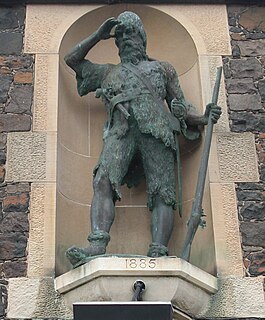
Alexander Selkirk was a Scottish privateer and Royal Navy officer who spent four years and four months as a castaway (1704–1709) after being marooned by his captain on an uninhabited island in the South Pacific Ocean. He survived that ordeal, but succumbed to tropical illness years later while serving aboard HMS Weymouth off West Africa.

Plymouth is a port city and unitary authority in South West England. It is located on the south coast of Devon, approximately 37 miles (60 km) south-west of Exeter and 190 miles (310 km) south-west of London. It is bordered by Cornwall to the west and south-west.

Plymouth Hoe, referred to locally as the Hoe, is a large south-facing open public space in the English coastal city of Plymouth. The Hoe is adjacent to and above the low limestone cliffs that form the seafront and it commands views of Plymouth Sound, Drake's Island, and across the Hamoaze to Mount Edgcumbe in Cornwall. The name derives from the Anglo-Saxon word hoh, a sloping ridge shaped like an inverted foot and heel.
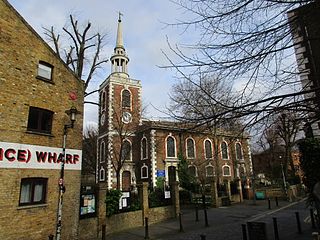
Rotherhithe is a residential district in south-east London, England, and part of the London Borough of Southwark. Historically the area was the most northeastern settlement in the county of Surrey. It is located on a peninsula on the south bank of the Thames, facing Wapping and Limehouse on the north bank, and is a part of the Docklands area. It borders Bermondsey to the west and Deptford to the south east.

The South West Coast Path is England's longest waymarked long-distance footpath and a National Trail. It stretches for 630 miles (1,014 km), running from Minehead in Somerset, along the coasts of Devon and Cornwall, to Poole Harbour in Dorset. Because it rises and falls with every river mouth, it is also one of the more challenging trails. The total height climbed has been calculated to be 114,931 ft (35,031 m), almost four times the height of Mount Everest. It has been voted 'Britain's Best Walking route' twice in a row by readers of The Ramblers' Walk magazine, and regularly features in lists of the world's best walks.

Newlyn is a seaside town and fishing port in south-west Cornwall, UK.
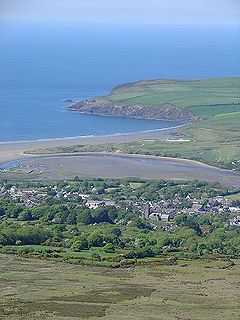
Newport is a town, parish, community, electoral ward and ancient port of Parrog, on the Pembrokeshire coast in West Wales at the mouth of the River Nevern in the Pembrokeshire Coast National Park.

Plymstock is a commuter suburb of Plymouth and former civil parish in the English county of Devon.

The Llandoger Trow is a historic public house in Bristol, south-west England. Dating from 1664, it is on King Street, between Welsh Back and Queen Charlotte Street, near the old city centre docks. Named by a sailor who owned the pub after Llandogo in Wales which built trows, the building was damaged in World War II, but remained in sufficiently good condition to be designated Grade II* listed building status in 1959. The pub is said to have inspired Robert Louis Stevenson to write of the Admiral Benbow Inn in Treasure Island and Daniel Defoe supposedly met Alexander Selkirk there, his inspiration for Robinson Crusoe. The pub is also supposedly haunted, with up to 15 ghosts, the best known being a small child whose footsteps can be heard on the top floor.
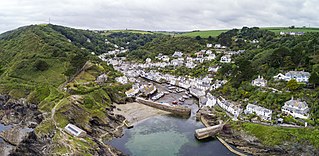
Polperro is a large village, civil parish, and fishing harbour within the Polperro Heritage Coastline in south Cornwall, England. Its population is around 1,554.

Winterton-on-Sea is a village and civil parish on the North Sea coast of the English county of Norfolk. It is 8 miles (13 km) north of Great Yarmouth and 19 miles (31 km) east of Norwich.

Calstock railway station is an unstaffed railway station on the Tamar Valley Line serving the village of Calstock in Cornwall, United Kingdom. It is situated at grid reference SX 433 688 at the north end of Calstock Viaduct which carries the railway at high level over the River Tamar.

Welcombe is a village and civil parish on the coast of north Devon, England, just north of the border with Cornwall. It is part of the district of Torridge. The population taken at the 2011 census was 187.
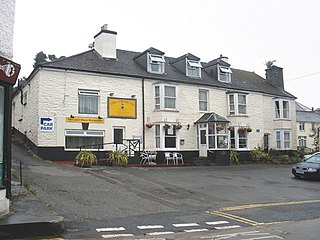
Gunnislake is a large village in east Cornwall, England, United Kingdom. It is situated in the Tamar Valley approximately ten miles (16 km) north of Plymouth

Hooe is a suburb of Plymstock, Plymouth in the English county of Devon.

The History of Plymouth in Devon, England, extends back to the Bronze Age, when the first settlement began at Mount Batten a peninsula in Plymouth Sound facing onto the English Channel. It continued as both a fishing and continental tin trading port through the late Iron Age into the Early Medieval period, until the more prosperous Saxon settlement of Sutton, later renamed Plymouth, surpassed it. With its natural harbour and open access to the Atlantic, the town found wealth and a national strategic importance during the establishment of British naval dominance in the colonisation of the New World. In 1620 the Pilgrim Fathers departed from Plymouth to establish the second English colony in America. During the English Civil War the town was besieged between 1642 and 1646 by the Royalists, but after the Restoration a Dockyard was established in the nearby town of Devonport. Throughout the Industrial Revolution Plymouth grew as a major mercantile shipping industry, including imports and passengers from the US, whilst Devonport grew as a naval base and ship construction town, building battleships for the Royal Navy – which later led to its partial destruction during World War II in a series of air-raids known as the Plymouth Blitz. After the war was over, the city centre was completely rebuilt to a new plan.

The Dylan Thomas Trail runs through places associated with the poet Dylan Thomas in Ceredigion, west Wales. It was officially opened by Aeronwy Thomas, Dylan’s daughter, in July 2003. It also featured in the celebration in 2014 of the centenary of Dylan's birth.

Merrymeet is a village in north of the parish of Menheniot in east Cornwall, England. Merrymeet is on the A390 main road.

The Percuil River is an estuary and stream draining the southern part of the Roseland Peninsula of Cornwall, UK and is one of three major tidal creeks of the River Fal. The small port and holiday destination of St Mawes is on the western shore and is linked to Place Creek on the eastern shore by the Place Ferry. The ferry is used by walkers on the South West Coast Path.